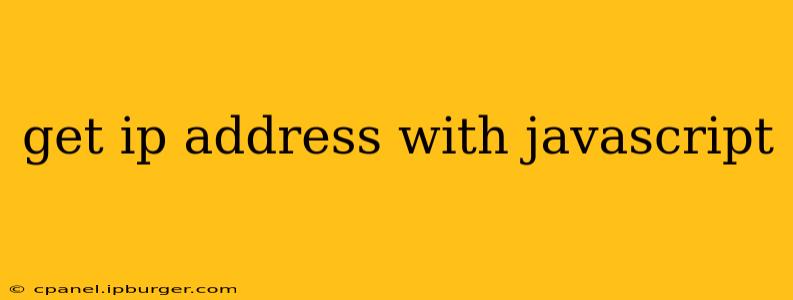Getting a user's IP address using JavaScript presents a unique set of challenges due to privacy concerns and browser limitations. While directly accessing the IP address from the client-side is largely impossible due to security restrictions, there are several methods that can provide approximations or leverage server-side processing to achieve this goal. This article will explore these methods, highlighting their limitations and potential use cases.
Why Directly Accessing the IP Address is Difficult
Modern web browsers prioritize user privacy and have implemented significant restrictions to prevent websites from directly accessing a user's IP address without explicit consent. This is primarily due to concerns about tracking and potential misuse of personal data. Attempts to circumvent these restrictions are often blocked by the browser itself.
Methods for Obtaining (or Approximating) an IP Address
While a precise, client-side-only solution is unavailable, several approaches can provide information related to a user's network location:
1. Using a Server-Side Proxy
This is the most reliable method for obtaining a user's IP address. The client-side JavaScript sends a request to a server, and the server then uses its own mechanisms to determine the client's IP address. This address is then sent back to the client. This approach requires setting up a server-side component and dealing with the complexities of server-side programming (like Node.js, Python with Flask/Django, etc.).
Pros: Most accurate method. Cons: Requires server infrastructure and introduces additional latency. Also raises security concerns related to server security and data protection.
2. Using a Third-Party API
Several third-party APIs offer IP address lookup services. These services generally work by having the client-side JavaScript send a request to their API, and the API returns the IP address. Popular examples are available, but be cautious about the data privacy policies of these services. Always check their terms of service and ensure they comply with relevant regulations (like GDPR).
Pros: Relatively simple to implement. Cons: Relies on a third-party service, which might affect performance or introduce additional costs. Data privacy should be a key consideration.
3. navigator.userAgent (Highly unreliable):
While navigator.userAgent provides information about the user's browser and operating system, it does not provide the IP address. Any attempt to extract IP information from this string is highly unreliable and prone to errors. Do not rely on this method.
4. RTCPeerConnection (Not Reliable for IP Address Determination):
The RTCPeerConnection API, primarily used for WebRTC communication, can sometimes reveal information about the user's network. However, it's not designed for IP address retrieval and the data obtained is often unreliable or inaccurate. Furthermore, its reliability is greatly influenced by Network Address Translation (NAT) and other network configurations. This should not be used to get an IP address reliably.
Ethical and Legal Considerations
Before attempting to obtain a user's IP address, consider the ethical and legal implications. Always prioritize user privacy and ensure you comply with relevant data protection regulations (such as GDPR or CCPA). Clearly inform users about how you are collecting and using their IP address information and obtain their consent where required.
Conclusion
Obtaining a user's IP address in JavaScript directly is not feasible due to browser security measures. Server-side proxies or third-party APIs offer more reliable solutions, but careful consideration should be given to the associated privacy and legal implications. Always prioritize user privacy and transparency. Remember to clearly communicate your data collection practices to your users and obtain their consent as required by applicable regulations.
